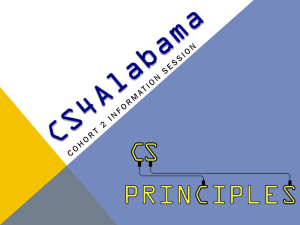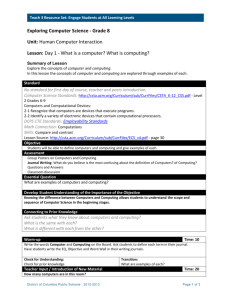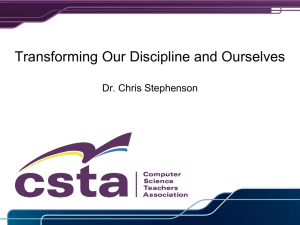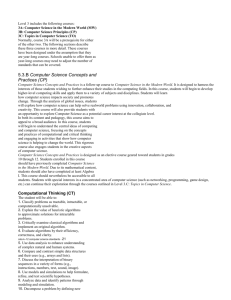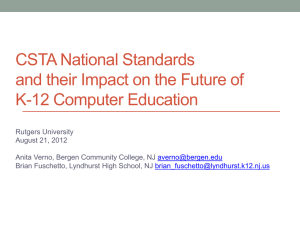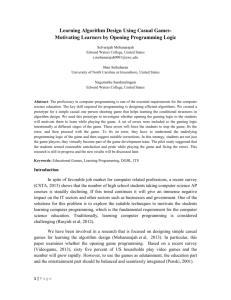Volume 7 issue 6 - CSTA
advertisement
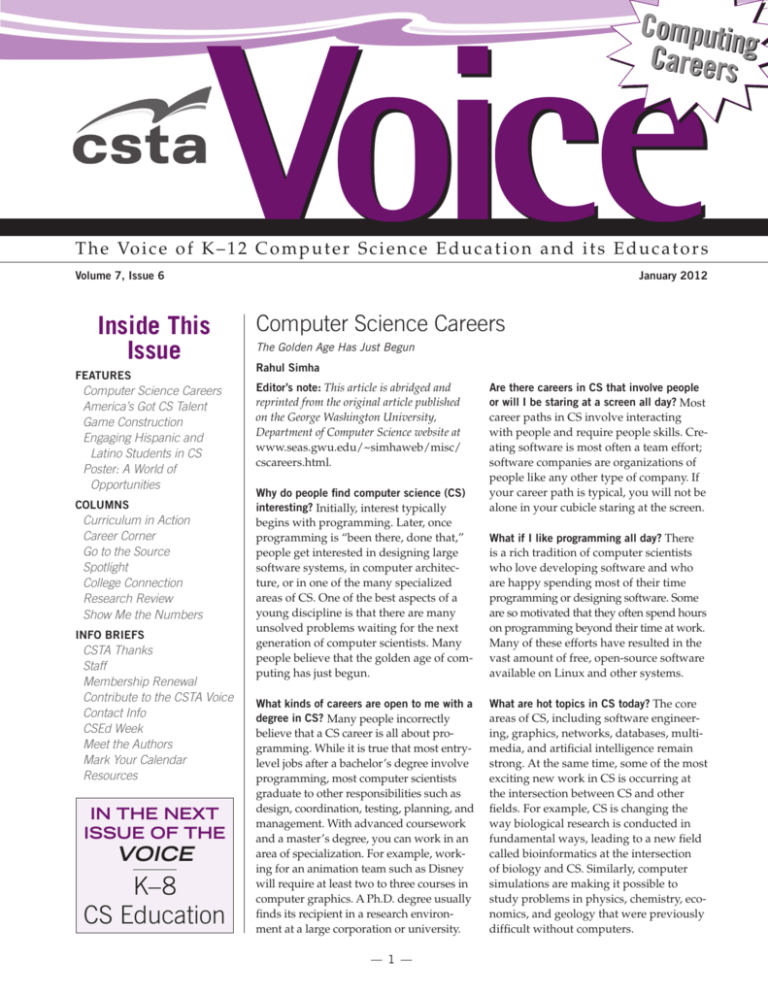
Voice Computi n Careers g T h e Vo i c e o f K – 1 2 C o m p u t e r S c i e n c e E d u c a t i o n a n d i t s E d u c a t o r s Volume 7, Issue 6 Inside This Issue features Computer Science Careers America’s Got CS Talent Game Construction Engaging Hispanic and Latino Students in CS Poster: A World of Opportunities columns Curriculum in Action Career Corner Go to the Source Spotlight College Connection Research Review Show Me the Numbers info briefs CSTA Thanks Staff Membership Renewal Contribute to the CSTA Voice Contact Info CSEd Week Meet the Authors Mark Your Calendar Resources In The Next Issue of The Voice K–8 CS Education January 2012 Computer Science Careers The Golden Age Has Just Begun Rahul Simha Editor’s note: This article is abridged and reprinted from the original article published on the George Washington University, Department of Computer Science website at www.seas.gwu.edu/~simhaweb/misc/ cscareers.html. Why do people find computer science (CS) interesting? Initially, interest typically begins with programming. Later, once programming is “been there, done that,” people get interested in designing large software systems, in computer architecture, or in one of the many specialized areas of CS. One of the best aspects of a young discipline is that there are many unsolved problems waiting for the next generation of computer scientists. Many people believe that the golden age of computing has just begun. What kinds of careers are open to me with a degree in CS? Many people incorrectly believe that a CS career is all about programming. While it is true that most entrylevel jobs after a bachelor’s degree involve programming, most computer scientists graduate to other responsibilities such as design, coordination, testing, planning, and management. With advanced coursework and a master’s degree, you can work in an area of specialization. For example, working for an animation team such as Disney will require at least two to three courses in computer graphics. A Ph.D. degree usually finds its recipient in a research environment at a large corporation or university. — 1 — Are there careers in CS that involve people or will I be staring at a screen all day? Most career paths in CS involve interacting with people and require people skills. Creating software is most often a team effort; software companies are organizations of people like any other type of company. If your career path is typical, you will not be alone in your cubicle staring at the screen. What if I like programming all day? There is a rich tradition of computer scientists who love developing software and who are happy spending most of their time programming or designing software. Some are so motivated that they often spend hours on programming beyond their time at work. Many of these efforts have resulted in the vast amount of free, open-source software available on Linux and other systems. What are hot topics in CS today? The core areas of CS, including software engineering, graphics, networks, databases, multimedia, and artificial intelligence remain strong. At the same time, some of the most exciting new work in CS is occurring at the intersection between CS and other fields. For example, CS is changing the way biological research is conducted in fundamental ways, leading to a new field called bioinformatics at the intersection of biology and CS. Similarly, computer simulations are making it possible to study problems in physics, chemistry, economics, and geology that were previously difficult without computers. Voice CSTA thanks CSTA ________________ wishes to thank Hélène Debra Martin for her dedicated work as ________________ Chair of the CSTA Advisory Council. for creating the new interactive CSTA Secondary CS Survey map. csta.acm.org/Research/sub/ HighSchoolSurveys.html Executive Officers Stephen Cooper Chair cooper@cs.stanford.edu Michelle Hutton Past Chair mfh@pobox.com Staff Dr. Chris Stephenson CSTA Executive Director Phone: 1-800-401-1799 Fax: 1-541-687-1840 cstephenson@csta.acm.org Pat Phillips Editor Phone: 1-608-436-3050 Fax: 1-928-855-4258 cstapubs@csta.acm.org Committees Certification cstacertification@csta.acm.org Curriculum cstacurriculum@csta.acm.org Funding Development cstagrants@csta.acm.org Membership cstahelp@csta.acm.org Professional Development cstapd@csta.acm.org Research cstaresearch@csta.acm.org Computer Science Careers continued from page 1 What are some challenges left open in CS for my generation? Some people wonder if all the important problems in CS have been solved, leaving only tinkering for future generations. Nothing could be further from the truth. Perhaps the most important theoretical objective in CS, the P=NP question, remains unsolved to this day. In fact, this is one of seven Millennium Prize Problems for which the Clay Mathematics Institute is offering a $1 million prize to the author of a solution. Applications of CS to other disciplines have only begun to scratch the surface. Can CS be combined with other fields of study? CS is unlike many other disciplines in that there is a large intersection with other fields. This makes it possible to “dual-major” in CS and another field in a meaningful way. For example, CS plus: • biology can lead to a career in bioinformatics, • economics will help solve problems in economics via computer simulation, • political science or criminal justice can lead to a career in security and information policy, • fine arts has obvious implications for a career in animation, and • business can lead to information technology career. Is studying CS useful if I really want to major in something else? For those disciplines that intersect with CS, the answer is clear, but what about history or English? An honest answer to this question would have to include a comment from a recent history major: “I really want CSTA Voice ISSN: 1555-2128 CSTA Voice is a publication of the Computer Science Teachers Association. CSTA Voice is a quarterly publication for members of the Computer Science Teachers Association. It provides analysis and commentary on issues relating to K–12 computer science education, resources for educators, and information for members. The publication supports CSTA’s mission to promote the teaching of computer science and other computing disciplines. Change of Address and Membership Questions: Contact Member Services via e-mail at cstahelp@csta.acm.org, or call 1-800342-6626 (U.S. & Canada) or +1-212-626-0500 (Global). Reproduction Rights Information: No part of this publication may be reproduced or transmitted in any form or by any means, electronic or mechanical, including photocopy, recording or information storage and retrieval system, without permission in writing from the publisher. Exception: permission to photocopy [individual] items for internal or personal use is hereby granted by CSTA. — 2 — to study history, but I see CS as a backup in the job market.” Fair enough. However, consider that CS also provides a certain kind of intellectual training, one that is focused on logical thinking, mastery of detail, teamwork, and multiple facets of problem-solving. CS students find the logical-thinking tests on the LSAT (law school exam) and GMAT (business school exam) quite easy. Many students bound for medical school also study CS. And, yes, it helps to have a backup! Why is CS so hard? Initially, it does seem that way. The reason that programming is challenging for many students is that they have not had many opportunities to learn CS. Compare this to the study of mathematics: math is with us from first grade and introduced in small steps throughout school. While there are always students who appear to find programming easy and who unnecessarily intimidate others into believing they are not suited to CS, most of us learn skills step-by-step over time. Can someone with no musical background learn a musical instrument in one semester? Can you learn to speak a foreign language fluently with a single course? What does it take to be successful in CS? CS is a unique kind of problemsolving: creatively solving problems using computation. If you are creative, if you like puzzles, if you like problemsolving in other domains (engineering, mathematics, sciences), if you are comfortable with abstract thinking, if you like working at the intersection of multiple disciplines, then CS is for you. Criteria for submitting articles: Potential writers for CSTA should send a brief description of the proposed article, estimated word count, statement of value to members, author’s name & brief bio/background info, and suggested title to the editor at cstapubs@csta.acm.org. The final length, due date and title will be negotiated for chosen articles. Notice to Authors Contributing to CSTA Newsletter: By submitting your article for distribution in this publication, you hereby grant to CSTA the following non-exclusive, perpetual, worldwide rights: • to publish in print on condition of acceptance by the editor • to digitize and post your article in the electronic version of this publication • to allow users to copy and distribute the article for noncommercial, educational or research purposes However, as a contributing author, you retain copyright to your article and CSTA will make every effort to refer requests for commercial use directly to you. CSTA: The Voice of K–12 Computer Science Education and its Educators America’s Got CS Talent Editor’s note: Miral Kotb is a dancer, choreographer, entrepreneur, AND a computer scientist. You may have seen her in the iLuminate performance that placed third in the final competition of America’s Got Talent television show this past summer. The audio interview is available in the CSTA Podcasts. A video of the performance can be seen on www. youtube.com/watch?v=1bMSbjn5Dng. my teams, including wardrobe designers, technicians who create all of the lighting, and software developers are working together. And of course, I work as an artist to create the shows we are producing and performing all across the country. As a software developer, I know what will work and what won’t so I get to plan and direct the production. CSTA: Tell us about iLuminate. Miral: iLuminate is a company I created two and a half years ago to bring together computer science (CS) and dance. The dancers wear lights on their bodies that I can control wirelessly from my computer. The lights enhance the dancers’ movements; they can create illusions, such as appearing and disappearing on the dark stage, which brings a new element to dance. CSTA: Where did you get your CS training? Miral: I received a bachelor’s degree in CS from Columbia University in New York. Computer science is a very creative activity in solving problems and designing software in new and efficient ways. CSTA: Where has iLuminate performed? Miral: We have worked Chris Brown, Christina Aguilera, Death Cab for Cutie, and The Black Eyed Peas, as well as in a movie and on American Music Awards, BET Awards, and the X Factor. We performed on America’s Got Talent and that experience pushed us to a new level of performance and to a wider audience. CSTA: How have you connected your two passions – dance and technology? Miral: CS is a very creative activity in solving problems and designing software in new and efficient ways. The arts and technology are not very different from each other. For me as a choreographer, technology presents just a different medium for expression. Computer scientists are not nerds; they are artists in their own powerful way. CSTA: Tell us about your current career in CS? Miral: I work fulltime for iLuminate. I’m not writing as much software as I did when I first created the project. Now I’m more of a manager; I make sure that all of CSTA: Who were your mentors as a student or young professional? Miral: There were two that impacted my life a great deal. The first is a professor of artificial intelligence (AI) who organized a game night in which everyone wrote their own game AI and matched their bots against each others’ bots. It was a fun class and made me think about how I could creatively generate fun with technology. The other was a dancer who was fascinated with technology. He encouraged me to combine the two. Before that time, I worked with technology during the day and then attended dance rehearsals in the evening. He helped me to think about how dance and technology could be combined. CSTA: What advice do you have for students who love CS as well as other areas? Miral: My advice is to think outside the box. Try to think about all the ways you can apply what you are learning. There are so many possibilities. And very importantly, keep having fun. Where you go with technology is up to you. CSTA: What plans and dreams do you have for your future with CS and dance? Miral: I want to merge dance and technology even further with audience interactive elements. Currently the audience just watches a performance; I want them to participate through technology. — 3 — Let us know if your contact information changes. cstephenson@csta.acm.org Contribute to the CSTA Voice The editorial board of the CSTA Voice is dedicated to ensuring that this publication reflects the interests, needs, and talents of the CSTA membership. Please consider sharing your expertise and love for computer science education by contributing newsletter content. Potential writers for the CSTA Voice should send a brief description of the proposed article, estimated word count, statement of value to members, author’s name and brief bio/background info, and suggested title to the editor at: cstapubs@csta. acm.org. The final length, due date, and title will be negotiated for chosen articles. Please share your knowledge. Volunteer today! The CSTA Voice welcomes your comments. E-mail: cstapubs@csta.acm.org Phone: 1-608-436-3050 Fax: 1-928-855-4258 Letters to the Editor are limited to 200 words and may be edited for clarification. ACM founded CSTA as part of its commitment to K–12 computer science education. Voice Be a leader in YOUR CSTA! Call for Nominations CSTA Board of Directors Nominations deadline: February 1, 2012 (Two-year terms) At-Large Representative International Representative School District Representative State Department Representative Teacher Education Representative University Faculty Representative Official notice enclosed Meet current board members csta.acm.org/About/sub/ BoardofDirectors.html Game Construction A Better Path to CS for Female Students Duane Szafron and Mike Carbonaro In a recent research project conducted at the University of Alberta, we have discovered that game creation, rather than game playing, may be the best path into computer science (CS) for female students. No one is surprised to hear that males dominate CS or that males play video games more than females. In fact, a recent study revealed that the top reason identified for males selecting CS was their experience with video games, whereas for females, it was their desire to use their CS knowledge in another area of study. We were surprised, however, to discover that although males play more games, game creation is an excellent vehicle for promoting female interest in CS careers. Our original research project was not about CS education or gender issues. Instead, it was aimed at providing high school students with an alternative activity to traditional story writing. Our hypothesis was that some students, who do poorly in traditional writing activities, might do better with an alternative story creation activity. The results of our study showed that some students who were low achievers in traditional story writing performed very well at creating video game stories. Originally, we were concerned that, since male students had more experience with playing video games than female students, the male students might be more motivated and therefore perform better than female students at video game construction. We found, however, that there was no difference in achievement or enjoyment between the males and females. And so we began to wonder if this might actually provide a solution for the underrepresentation of women in university CS programs. We have taught first year university CS courses for many years and have detected no difference in the enthusiasm or achievement of female and male students. What we have seen, however, is that undergraduate females seem more interested in using CS to solve problems than in techniques or hardware. This led us to wonder if our female students would be more interested in CS as a discipline if we focused on creating systems and solving problems, rather than on the rules and regulations for writing programs. These reflections further led us to conjecture that video game construction might serve as an alternate entry point into CS that could capture the interest of a higher percentage of female students. We believe that students learn much of the same material by the end of the semester even though this approach focuses on creativity and modeling, not on programming techniques. — 4 — So, next semester we will be teaching our first-year course in a completely different way. Rather than covering topics such as variables, control structures, parameters, objects, methods, containers, searching, sorting, recursion and inheritance, we will be covering topics such as building text-based games, building games with improved user interaction, using graphics to build more engaging games, and so on. We believe that students will learn much of the same material by the end of the semester even though this approach focuses on creativity and modeling, not on programming techniques. It will be interesting to see if this approach changes the number of female students who take additional CS courses or more importantly, select CS as their major. Learn more about this research in the Equity Binder accessible from the CSTA website: Carbonaro, M., Szafron, D., Cutumisu, M, & Schaeffer, J. (2010). Computer-game construction: A genderneutral attractor to Computing Science, Computers & Education. 55(3), 1098-1111 (csta. acm.org/Resources/sub/VirtualBinders.html). CSTA: The Voice of K–12 Computer Science Education and its Educators Engaging Hispanic and Latino Students in CS Mini-grants available The vision of the Computer Science Collaboration Project (CSCP) is to efficiently increase participation of underrepresented groups in CS opportunities and activities by effectively building collaborations between K-12, community-based organizations, higher education and industry. The project, led by the EdLab Group with support from CSTA, is accepting applications for grants to fund CS projects being sponsored through collaborations across organizations working toward a common goal of increasing the participation and engagement of Hispanic/Latino/a youth. • To apply for a mini-grant, at least two programs from different organizations must collaborate on a project. All programs/organizations collaborating on the mini-grant must be registered in the CSCP Program Directory found at www.cscproject.org. • The mini-grants are considered seed funding and are not intended to fully fund entire projects. There are two grant funding levels: 1) up to $1,000 and 2) up to $3,000. • Proposals must present a well-defined project with procedures and activities that are linked to CSCP goals and objectives. • Projects must focus on CS rather than computer literacy; the ability to create, adapt, and innovate new technologies distinguishes CS from literacy, which focuses more on merely using technology. • Application deadline: February 17, 2012. The CSCP provides free resources (including webinars, links to relevant projects, related articles, and research) via a content-rich website, an e-newsletter, presentations at national conferences, a program directory, as well as a mini-grant program intended to build capacity for collaborative projects. Apply on line beginning January 20, 2012 at www.cscproject.org. Poster: A World of Opportunities Each year CSTA celebrates Computer Science Education Week by releasing a new resource that communicates the excitement of computer science (CS) to students. The “World of Opportunities” poster highlights exciting careers in four key areas: medical informatics, mobile apps and animation, computer mapping, and cyber forensics. This poster was developed by CSTA in partnership with CCECC (Committee for Computing Education in Community Colleges). Several other posters and brochures are available. The “Computer Science in Sports” poster invites students to make the connections between CS and their favorite sports. The “Computing: Expand Your Connections” poster illustrates the opportunities that computing provides for realizing goals and dreams. The “IT is All About Me” poster, designed with young women in mind, shows the links between popular professions and CS. All of these posters can also be downloaded from the CSTA website at: csta.acm. org/Resources/sub/BrochuresPostersVideos. html. CSTA members can request copies for outreach events or their classroom from Lissa Clayborn at l.clayborn@hq.acm.org. Correction The link for adding the CS History Gadget to your website was incorrect in the CSEdWeek: Ideas to Fit Your Schedule article of the November Voice. The CS History Gadget can be accessed from csta.acm.org/includes/Gadget.html. — 5 — Meet the Authors Mike Carbonaro University of Alberta, Edmonton Mike is a Professor of Educational Psychology. His current research and teaching topics include e-learning technologies, LEGO robotics, and game development tools for interactive story-writing and constructionist learning. Ben Chun San Francisco, CA Ben teaches CS at Galileo Academy of Science & Technology, a comprehensive public high school in San Francisco Unified School District. John P. Comiskey Staten Island, NY John teaches AP calculus and AP CS at Monsignor Farrell High School. Joanna Goode University of Oregon Joanna previously worked as a mathematics and CS teacher at an urban Los Angeles area high school. She is the co-author of the Exploring Computer Science curriculum and co-author of Stuck in the Shallow End: Education, Race, and Computing. Joe Kmoch Milwaukee, WI Joe Kmoch has worked with Debbie Carter in the development of the CSTA Source web repository since 2003. Currently he is retired and working as a CS consultant. Scott Portnoff Los Angeles, CA Scott is a full-time CS instructor at the Downtown Magnets High School. He is the author of Saffa, a talking Hebrew educational software program. Rahul Simha George Washington University, Washington, DC Rahul is engaged in research in security, embedded systems, simulation, and complex systems. He has been involved in workshops for K-12 teachers, curricular development, and assessment. Duane Szafron University of Alberta, Edmonton Duane is a Professor of Computing Science. His current research interests are in computer games, especially believable characters in video games and agents for computer poker. Voice Curriculum in Action Lessons Learned Teaching AP CS John P. Comiskey A few years ago, a student I had taught in high school contacted me to ask questions about a programming assignment she had received in a college computer science (CS) class. I answered several of her questions, but after a few messages back and forth, I realized that I did not understand the purpose of the program. Finally, I asked her, “Exactly what is this program supposed to do?” She could not answer the question. She was attempting to write a program without knowing what it was supposed to do. As a result of this incident, I developed a method for teaching Advanced Placement (AP) CS. It is intended to answer the question students often ask about programming assignments: “How do I start?” For a programming task on the AP CS exam, students are typically presented with a situation and details such as: a description of the code needed to computerize the situation; some code snippets; and instructions to write some methods. As a rule, they are not asked to write the entire program. To help students figure out “how to start,” I’ve come up with a successful strategy. Each year after the AP CS exam, I write the entire program for each question. Then I place the solution on the school network with the methods deleted and assign students to complete the program by filling in the missing code. But before they begin writing code, they must complete a planning sheet for each method. I show the students the output produced by my solution and then the students actually begin to write the code. • Explain, in simple language and without using computer terms, what this method is supposed to do. • List the programming features and routines (e. g., cast, binary search) which this method will employ. • How will these features and routines be used in writing the method? After having learned with this method, exam takers reported that the planning sheets gave them a blueprint, which helped them to approach coding in an organized, step-by-step fashion. The planning sheet is designed specifically to prepare students to analyze and think about the type of programming questions that often appear in CS courses and on exams. This is supplemental to the other problem-solving strategies they learn in class such as the waterfall model and top-down design. Ben Chun I learned to program because… • I wanted a new way to express my creativity. • I wanted to build cool things. • This is the easiest medium for creating something out of nothing. • My parents wouldn’t let us play video games; I learned BASIC and wrote one. We know from numerous studies that social factors, particularly peer support and interaction, have a significant impact on retention of women and underrepresented groups in computer science (CS). Role models can have a powerful Go to the Source Resources for CS Careers Joe Kmoch Y ou will find resources in the Source web repository for teaching about computer science (CS) careers. Visit the Source to download these items and browse through the growing collection of lessons, projects, and articles submitted by CSTA members and aligned to the ACM Model Curriculum for K-12 CS. And please, consider submitting one or more of your favorites. It is quick and easy with our online submission process at csta.acm.org/WebRepository/WebRepository.html. Post-secondary Careers Assignment by Brad Strassburger L2A10, L3A10: Careers in Computing csta.villanova.edu/handle/2378/414 In this assignment, students explore post-secondary education and career options. Students create a website to communicate the information that they find. This specific assignment is for a grade 11 or above introductory CS course, but can be easily modified to fit any computer studies or computer engineering course. Planning Sheet Career Corner impact on your students and enable them visualize themselves as computer scientists. Online resources such as ilearnedtoprogram.com can help students identify with people who learned to program at different points in their lives and for a variety of reasons. Over 500 statements are available on the site, all reviewed as schoolappropriate before publication. Significantly, over a third of these stories are from females. Use the ilearnedtoprogram.com website to help your students envision themselves in CS. Just click on the “reload page” icon in the browser to cycle through the statements. Click on the contributors’ names to learn more about their lives and work in CS. Perhaps some of your students will even submit their own stories for publication. Computing Career Exploration: An Interview by Stephanie Ludi L2A10, L3A10: Careers in Computing csta.villanova.edu/handle/2378/336 In this assignment, students explore career options in computing by interacting with practitioners in the community or online. Students practice written and oral communication skills including sharing their knowledge with peers. Spotlight Teaching CS As If the Rest of the World Existed Scott Portnoff T eaching High School CS As If the Rest of the World Existed is a Special Session scheduled at SIGCSE on Friday, March 2, 2012. The presentation is an interim report on an intermediate-level computer science curriculum of interdisciplinary, problem-based units that model real-world applications. In multi-week units students solve problems with sophisticated applications such as the San Diego Supercomputer Center Biology Workbench. In this particular unit they build a phylogenetic tree based upon DNA sequences from different species. They then build a small-scale version of the program—focusing on one or two algorithms—using Processing, Excel, BYOB, or Alice. — 6 — CSTA: The Voice of K–12 Computer Science Education and its Educators This approach allows students to explore programs and affords them both context and practical potential for their projects. Back-stories from film and literature place problems within an historical or social context to help explain why solving such problems is important. Unit topics come from the fields of astronomy, bioinformatics, molecular modeling, political and environmental science, music, and Holocaust studies. The full description is available at www.hebrewworks.com/ HS-CS-Education/SIGSCE/SIGSCE-Special-Session-ProposalScott-Portnoff.pdf. SIGCSE 2012 will be held in Raleigh, NC. The session is based upon a SIGCSE Special Projects Grant that was funded in the August 2011 cycle. College Connection Walden University Editor’s note: This dialogue with Dr. Colin W. Wightman, Interim Associate Dean, College of Management and Technology at Walden University, is a continuation of our series of interviews with CSTA institutional members. Unlike previous College Connection interviews, the details about Walden University are of primary interest to you as a teacher for your professional development. For more than 40 years, Walden University has been serving the higher education needs of working professionals by providing quality distance-learning education. Walden’s School of Information Systems and Technology offers a variety of programs, including bachelor’s degrees in computer information systems (IS) and information technology (IT), and a graduate certificate in IS. At the graduate level, students can earn master’s degrees in IS, IS management, and IT. Admission to these programs is considered for adults who hold a high school diploma (or its equivalent) or for candidates who may have completed some college coursework. Candidates must also meet at least one of the following criteria: 24 years of age older; between 21 and 23 years of age with at least 12 transferrable credits; completion of at least 90 credits; or, an active member of the military or a veteran. CSTA: What draws students to your program? Wightman: Our flexible learning environment allows busy working professionals to reach their academic goals while still balancing their personal and professional commitments. Unique learning environments encourage students to gain practical experience while working effectively as part of a geographicallydispersed, multidisciplinary project team. CSTA: Tell us about innovative majors or programs. Wightman: Walden’s M.S. in IS program includes foundational courses that are tailored to people who didn’t choose an IS- or IT-related major as an undergraduate, allowing students who started in another field to pursue their interest in IS. To meet the growing demand for skilled web designers, mobile application developers, programmers, and usability specialists, we now offer two new concentrations: Web Systems Design and Usability in CIS; and Web Design and Applications Development in IT. The Project Management specialization in our Master of Information Systems Management program prepares students to design, plan, budget, and lead complex IS and IT projects. CSTA: What cool careers are your graduates prepared for? Wightman: Walden graduates are particularly well-prepared to apply and use IS and IT in social and business organizations. Their careers may include roles in application development, web development, systems integration, data administration, networking and telecommunications, operations, software development, security, quality assurance, and technical support. CSTA: What distinguishes your school and/or program? Wightman: The School of Information Systems and Technology offers virtual laboratories that simulate actual networking and routing scenarios that allow students to practice what they learn. Group projects give students the opportunity to work with fellow students from potentially around the world. Many courses offer MobileLearnSM, which lets students choose where, when, and even how they learn through their laptop, smartphone, or other handheld device. CSTA: Tell us about the diversity of the student population. Wightman: Our master’s and doctoral programs, in fields including education, business, public health, social service, nursing, psychology, and public administration, were ranked among the top five in multiple categories in Diverse: Issues in Higher Education’s 2011 Top 100 Producers of Minority Graduate Degrees. Research Review Measuring up on Equity Joanna Goode D o you wonder how your state measures up on equitable access to computer science (CS) education? A new data resource, available on the CSTA website, presents “participation rates” of historically underrepresented students in Advanced Placement (AP) CS. Accounting for the percentage of American Indian, African American, and Latino students enrolled in each state’s schools, this indicator reflects the proportion of students of color taking AP CS exams as a proportion of total student enrollment by race. An indicator less than “1” denotes that students of color are proportionally underrepresented in the state’s CS classrooms. All states included in this analysis had low representations of students of color. For example: • Arkansas (.59) and Florida (.54) have the most racially diverse classrooms nationwide. • Ohio (.13) and Indiana (.13) have the least racially diverse classrooms nationwide. Find your state’s participation rate data, broken down by racial groups, on the Research section of the CSTA website: csta.acm.org/Research/sub/CSTAResearch.html. show me the Numbers CS Participation for Students of Color States with the Highest and Lowest Participation Rates for Students of Color Schools Enrollment Percentage APCS Exam-Takers Percentage Participation Rate Arkansas 30.4% 18.0% .59 Florida 48.3% 26.1% .54 Massachusetts 22.8% 9.8% .43 State HIGHEST LOWEST Colorado 32.6% .6% 5.3% .16 Indiana 18.1% 2.4% .13 Ohio 19.6% 2.6% .13 Source: csta.acm.org/Research/sub/CSTAResearch.html — 7 — Voice Computer Science Teachers Association 2 Penn Plaza, Suite 701 New York, NY 10121-0701 We’re on the Web! csta.acm.org mark your calendar FETC January 23–26, 2012, in Orlando, Florida fetc.org/Events/Florida-Educational-TechnologyConference/Home.aspx Consortium for Computing Sciences in Colleges (CCSC: South Central) April 20–21, 2012, in Canyon, Texas www.sci.tamucc.edu/ccsc TCEA February 6–10, 2012, in Austin, Texas tcea2012.org/2012/public/default.html Consortium for Computing Sciences in Colleges (CCSC: Northeastern) April 27–28, 2012, in Hamden, Connecticut www.ccscne.org/ SIGCSE 2012 February 29–March 3, 2012, in Raleigh, North Carolina www.sigcse.org/sigcse2012 Consortium for Computing Sciences in Colleges (CCSC: Southwestern) March 23–24, 2012, in Stockton, California www.ccsc.org/southwestern Consortium for Computing Sciences in Colleges (CCSC: Central Plains) March 30–31, 2012, in Springfield, Missouri www.ccsc.org/centralplains iARoC 2012 (International Autonomous Robot Competition) June 23–24, 2012, in San Diego, California sites.google.com/a/wintrisstech.org/iaroc ISTE Conference 2012 June 24–27, 2012, in San Diego, California isteconference.org/2012 CSTA’s Annual CS & IT Conference July 9–10, 2012, in Irvine, California www.cstaconference.org Consortium for Computing Sciences in Colleges (CCSC: Mid-South) March 30–31, 2012, in Jackson, Tennessee www.ccsc-ms.org resources Here’s more information on topics covered in this issue of the CSTA Voice. Page 1: Page 1: Page 1: Page 2: Page 2: Page 3: Page 3: Page 3: Page 4: Page 4: Page Page Page Page Page Page Page 5: 5: 5: 6: 6: 6: 6: Page 7: Page 7: George Washington University CS Careers www.seas.gwu.edu/~simhaweb/misc/cscareers.html George Washington University Department of Computer Science www.cs.gwu.edu The George Washington University www.gwu.edu Millennium Prize Problems www.claymath.org/millennium P vs. NP Problem www.claymath.org/millennium/P_vs_NP Miral Kotb Interview csta.acm.org/Communications/sub/Podcasts.html iLuminate performance www.youtube.com/watch?v=1bMSbjn5Dng iLuminate iluminate.com Carbonaro, M., Szafron, D., Cutumisu, M, & Schaeffer, J. (2010). Computer-game construction: A gender-neutral attractor to Computing Science, Computers & Education. 55(3), 1098-1111. Carter, L. (2006). Why Students with the apparent aptitude don’t choose to major in computer science, SIGCSE Bulletin, 38(1), 27-31. CS Collaboration Project www.cscproject.org CSTA Career Resources csta.acm.org/Resources/sub/BrochuresPostersVideos.html Saffa www.hebrewworks.com I Learned to Program ilearnedtoprogram.com Galileo Academy of Science & Technology Ben Chun’s Teacher Page galileoweb.org/chunb CSTA Source csta.acm.org/WebRepository/WebRepository.html SIGCSE Teaching HS Computer Science Special Session www.hebrewworks.com/ HS-CS-Education/SIGSCE/SIGSCE-Special-Session-Proposal-Scott-Portnoff.pdf Walden University meritas.waldenu.edu APCS Participation & Enrollment by Race csta.acm.org/Research/sub/CSTAResearch.html — 8 — Talk to us! CSTA Advocate Blog blog.acm.org/csta
